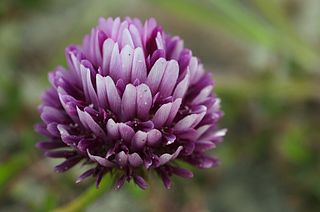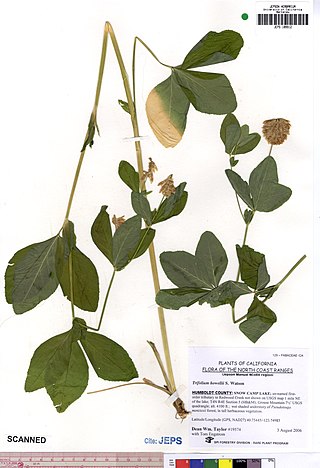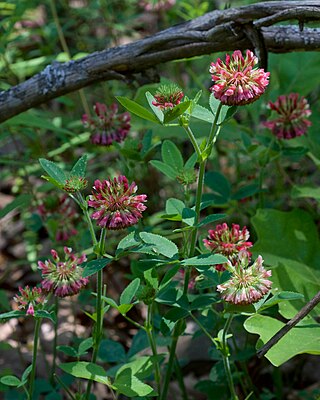
Trifolium stoloniferum, the running buffalo clover, is an endangered species of perennial clover native to the eastern and midwestern United States. From 1940 to 1983 it was believed to be extinct until two populations were discovered in West Virginia. Since then, more populations have been found in the US but it still remains one of the most imperiled plants in North America.

Trifolium wormskioldii is a species of clover native to the western half of North America. Its common names include cows clover, coast clover, sand clover, seaside clover, springbank clover, and Wormskjold's clover.

Trifolium amoenum, known by the common names showy Indian clover and two-fork clover, is endemic to California, and is an endangered annual herb that subsists in grassland areas of the San Francisco Bay Area and the northern California Coast Ranges.

Trifolium trichocalyx is a species of clover known by the common name Monterey clover.

Trifolium albopurpureum is a species of clover known by the common name rancheria clover.
Trifolium andersonii is a species of clover known by the common names fiveleaf clover and Anderson's clover. It is native to the western United States, particularly the Great Basin and adjacent high mountain ranges, including the Sierra Nevada. It was named after Charles Lewis Anderson by Asa Gray.

Trifolium angustifolium is a species of clover known by the common names narrowleaf crimson clover, narrow clover and narrow-leaved clover.

Trifolium bifidum is a species of clover known by the common names notchleaf clover and pinole clover. It is native to the western United States from Washington to California, where it grows in many types of habitat. It is an annual herb spreading or growing erect in form. It is lightly hairy to hairless in texture. The leaves are made up of oval leaflets 1 to 2 centimeters long, usually with notches in the tips. The inflorescence is a head of flowers up to 1.5 centimeters wide. Each flower has a calyx of sepals that narrow to bristles covered in long hairs. The flower corolla is yellowish, pinkish, or purple and under a centimeter long. The flowers droop on the head as they age.
Trifolium bolanderi is a species of clover known by the common names Bolander's clover and parasol clover.
Trifolium breweri, which has the common names forest clover and Brewer's clover, is a perennial clover that is native to mixed evergreen forests and coastal coniferous forests in Southern Oregon and California.

Trifolium ciliolatum is a species of clover known by the common name foothill clover. It is native to western North America from Washington to Baja California.

Trifolium eriocephalum is a species of clover known by the common name woollyhead clover or hairy head clover.

Trifolium fragiferum, the strawberry clover, is a herbaceous perennial plant species in the bean family Fabaceae. It is native to Europe, Asia, and parts of Africa. It is present in other places, such as sections of North America, as an introduced species. It is also cultivated as a cover crop and for hay and silage, as green manure, and as a bee plant.

Trifolium fucatum is a species of clover known by the common names bull clover and sour clover. It is native to the western United States, where it grows in many types of habitat, becoming common to abundant in some areas. It is an edible species of clover.

Trifolium gracilentum is a species of clover known by the common names pinpoint clover and slender clover. It is native to western North America including the west coast of the United States and northwestern Mexico, where it grows in many types of habitat, including disturbed areas. It is an annual herb growing prostrate to erect in form with mostly hairless or slightly hairy herbage. The leaves are made up of lance-shaped to oval leaflets. The inflorescence is an umbel of flowers that spread out or flex downward. The flowers have pink or purple corollas less than a centimeter long.

Trifolium howellii is a species of clover known by the common names canyon clover and Howell's clover. It is native to Oregon and California, where it grows in moist and shady habitat types, such as swamps and forest streambanks.
Trifolium lemmonii is a species of clover known by the common name Lemmon's clover.

Trifolium longipes is a species of clover known by the common name longstalk clover. It is native to the western United States, where it occurs in many types of habitats such as meadows, valleys, lower mountains, and subalpine slopes. There are many subspecies and varieties which exist in different regions and differ slightly in appearance. In general, it is a perennial herb with leaves made up of 2 to 5 leaflets which vary in shape. The inflorescence is a head of flowers up to 3 centimeters wide with white to purplish or bicolored corollas.

Trifolium variegatum is a species of clover known by the common name whitetip clover. It is native to western North America from southern Alaska and British Columbia to Baja California, where it occurs in many types of habitat.

Trifolium reflexum, the Buffalo Clover, is a species of clover native to the Eastern United States. It is found in areas of natural openings including woodlands, glades, and prairies, often in acidic areas. It is an annual or biennial that produces white to dark pink flowers in the late spring.

















